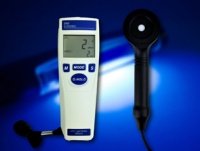How To Test Outdoor Air Quality

Emissions from vehicles, smoke, dust, fuel burning and industry are some of the many causes of outdoor pollution (also referred to as ambient air pollution). Many pollutants within emissions are harmful to human health when they occur in high concentrations.
This article discusses some major outdoor air pollutants and how you can monitor them.
Learn more here.
About Outdoor Air Quality
Even though it’s not always visible, outdoor air quality impacts our everyday lives. Outdoor air quality refers to the concentration of particular pollutants in the out-of-doors atmosphere.
Below we examine the most commonly measured pollutants in outdoor air, along with the corresponding safety standards set by the National Environment Protection (Ambient Air Quality) Measure.
1. Particulate Matter (PM2.5 and PM10)
Particulate matter refers to microscopic solid or liquid matter suspended in the air. You will often find particulate matter expressed as 'PM' with particulate matter size in micrometres (µm), for example, PM10, PM2.5 or PM1.
Adverse health effects are closely correlated to particulate matter size. The most common particulate matter measured by outdoor air quality meters is PM2.5. Levels of PM2.5 are known to cause cardiovascular and respiratory diseases and cancers. Sources of particulate matter include smoke from fires and wood heaters, car and truck exhaust, and airborne industry pollutants. For information on pollutant levels and maximum concentration standards for particulate matter, see Table 1 (below).
Pollutant |
Averaging period |
Maximum concentration standard |
Maximum allowable exceedances |
|
Particles as PM10 |
1 day |
50 µg/m3 |
None |
|
Particles as PM2.5
|
1 day |
25 µg/m3 |
None |
Table 1 Particulate Matter levels and maximum concentration (Source: National Environment Protection (Ambient Air Quality) Measure 2015)
2. Nitrogen Dioxide (NO2)
Nitrogen Dioxide is a highly reactive gas formed by emissions from vehicles and industry. Short term exposure to high levels of Nitrogen Dioxide can act as an irritant to the eyes and nose. Repeated or long term exposure results in acute or chronic bronchitis.
NO2 is the primary source of nitrate aerosols, which form a fraction of PM2.5. Further to this, the presence of Nitrogen Dioxide in the air can contribute to the formation and modification of other air pollutants, e.g. Nitrogen dioxide reacts with sunlight, leading to ozone (O3) formation. For information on pollutant levels and maximum concentration standards for nitrogen dioxide, see Table 2 (below).
Pollutant |
Averaging period |
Maximum concentration standard |
Maximum allowable exceedances |
|
Nitrogen dioxide |
1 hour |
0.12 ppm |
1 day a year |
Table 2 Nitrogen Dioxide levels and maximum concentrations (Source: National Environment Protection (Ambient Air Quality) Measure 2015)
3. Ozone (O3)
Ozone at or near ground level is one of the main components of photochemical smog. Ozone has several origins but commonly forms by a reaction between sunlight and various pollutions such as VOCs and nitrogen oxides. Ozone reaches maximum levels during sunny weather periods, leading to the risk of breathing issues, reduced lung function, and asthma attacks. Long term exposure can cause lung disease. For information on pollutant levels and maximum concentration standards for ozone, see Table 3 (below).
Pollutant |
Averaging period |
Maximum concentration standard |
Maximum allowable exceedances |
|
Photochemical oxidants (as ozone) |
1 hour |
0.10 ppm |
1 day a year |
Table 3 Ozone levels and maximum concentrations (Source: National Environment Protection (Ambient Air Quality) Measure 2015)
Other Pollutants
There’s a host of other common outdoor pollutants caused by emissions such as VOCs (Volatile Organic Compounds), carbon monoxide, sulphur dioxide, and lead. These pollutants, when present in outdoor air, may also harm health. See the full table of pollutant standards in Appendix 1, Table 4 (below).
How to Test Outdoor Air Quality
An outdoor air quality tester is the most efficient way to test and monitor outdoor air quality. There are outdoor air quality testers suitable for both home users and professional users. The most common application for outdoor testers include:
- Personal exposure data collection from around a home
- Environmental impact assessments
- Government air quality surveys
- Responding to complaints from the public; and
- Short term fixed monitoring on building sites.
Outdoor Air Quality Testers
Instrument Choice Scientists have prepared three examples of outdoor air quality testers listing with what they measure, their range and examples of applications.

AirLink Air Quality Sensor
|

Outdoor Air Quality Test Kit (Pro)
|

NEMo Outdoor
|
Conclusion
Whether you are looking to monitor outdoor air quality around the home, in public spaces or for research, there’s an extensive range of outdoor air quality testers available to suit any budget, parameter and accuracy requirements.
Didn’t see what you were looking for in the stations above? Browse all air quality sensors here.
Want more information on any of the products mentioned above? Speak with an Instrument Choice Scientist! We're here to help! Call 1300 737 871 or email [email protected].
ing to measure particulate matter around the home or workplace.

Appendix 1:
Pollutant |
Averaging period |
Maximum concentration standard |
Maximum allowable exceedances |
|
Carbon monoxide |
8 hours |
9.0 ppm |
1 day a year |
|
Nitrogen dioxide |
1 hour |
0.12 ppm |
1 day a year |
|
Photochemical oxidants (as ozone) |
1 hour |
0.10 ppm |
1 day a year |
|
Sulphur dioxide |
1 hour |
0.20 ppm |
1 day a year |
|
Lead |
1 year |
0.50 µg/m3 |
None |
|
Particles as PM10 |
1 day |
50 µg/m3 |
None |
|
Particles as PM2.5 |
1 day |
25 µg/m3 |
None |
Table 4 Standards for Pollutants as set by National Environment Protection (Ambient Air Quality) Measure 2015
Also interesting
Are the typical sound levels in your life injuring your hearing?
In this experiment, we carry around a sound level data logger to discover what sound levels we encounter day-to-day to determine whether they are hazardous.
See the experiment here

Instrument Choice regularly reviews new and popular products, so when searching for the perfect scientific instrument for your application, you can make more informed decisions.
This review assesses the UV Light Meter (Product Code: IC-850010). This review sheds light on the IC-850010’s impressive features, specifications and provides some examples of use.
Get your comprehensive scientists’ review of the UV Light Meter UVC IC-850010 here

